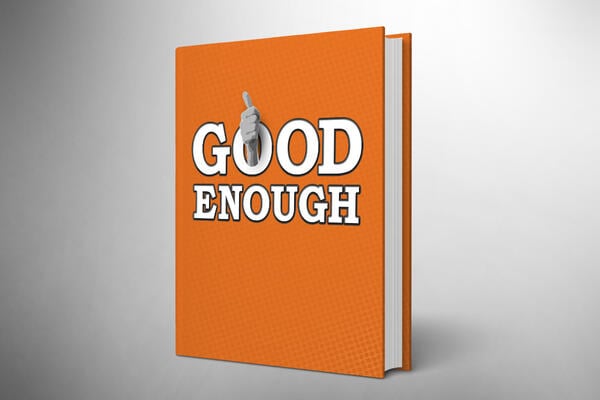
The Good Enough Manuscript (opinion)
I recently coached a scholar through drafting a proposal for her second book. Her manuscript is almost complete, and our work together involved putting together a strong pitch for a few of the university presses that publish in her field. As she shared the last component of her book proposal with me for feedback, she observed with satisfaction that the proposal was indeed coming together but that the hard part would be working up the nerve to send the project off. If she only knew how many times I’ve seen that “hard part” be the step that kept people from realizing the publishing success they so deserve.
As a professional developmental editor and publishing consultant who has spent the last 10 years helping academics bring their books and articles to print, I’m well-versed in the struggles of the scholarly writer. It’s no small feat to find time to research and write amid other professional obligations (like teaching and service) and personal commitments (like childcare, eldercare and self-care), not to mention national and global turbulence. Those who manage to complete a scholarly manuscript under these conditions should be applauded. But then the writer who has already accomplished so much faces another hurdle: persuading a press or journal to publish the text they’ve written.
A common reaction to this hurdle is to find ways to delay having to confront it. I see writers get stuck in endless rounds of revision, going back and forth about which citations to include, tinkering with sentence structure and word choice, waiting to contact publishers until they’ve landed on the perfect phrasing for their cover letters.
The truth is that the minute details don’t matter as much in the first submission as authors might think, especially at book publishers. You do want to put your best foot forward, to show that you value an editor’s time and that of the peer reviewers who will consider your work for publication. But it’s expected that your manuscript will evolve with the input of peer reviewers and that polishing words and sentences will happen during the final revision and copyediting stages. The writer’s goal when submitting to publishers should therefore not be a perfectly finished text, but a “good enough” manuscript that allows a press or journal to seriously consider whether they want to give a greater platform to the writer’s ideas.
But what constitutes “good enough” in the eyes of scholarly publishers? The first criterion publishers are looking for is a sense of fit with their existing offerings. This actually has little to do with the quality of your writing. It’s more about whether the readership that the press or journal has already cultivated is generally welcoming to the topic, methods and theoretical framework of your piece.
To ensure your manuscript is good enough in the area of fit, do your homework on what your target press or journal has recently published in the last year or two. Get clear on whom you are writing for and find outlets where those readers are already gathering. The risk of rejection goes down exponentially when you send your manuscript to the right place.
Turning to your manuscript itself, before sending it to a publisher, you should evaluate it for what I call the four pillars of scholarly writing: argument, evidence, structure and style. Scholarly manuscripts must have a solid foundation in all four areas to be successful in the publishing process, because each of these fundamental aspects of the text has the potential to make or break the text’s chances of being received well by peer reviewers, getting approved for publication and ultimately reaching readers in the author’s scholarly field and beyond.
Your argument is the main claim that drives your text and that you want readers to accept. Is it clearly stated near the beginning and does it remain present throughout the text? Your evidence backs up the argument for the reader. Do you have sufficient evidence and do you analyze it effectively to guide your reader to the points you want them to accept?
The structure of your manuscript supports the reader in encountering your evidence and absorbing your points in a logical and engaging order. Structural concerns include the way the text is organized into chapters, sections and paragraphs, as well as your use of titles, headings, transitions and other signposts to move your reader along. Have you put thought into why the components of your text are organized the way they are, and have you used appropriate cues to make the structural logic obvious to your reader? By style, I mean the overall presentation of your writing, including how your attitude toward both reader and subject matter shows up on the page. Depending on the publishing venue, the style of a scholarly manuscript may be informal or formal, passionate or detached. Consider what will be most effective with your most important readers and ensure stylistic consistency across your text.
After attending to big-picture matters, you will want to double-check that everything in your text is accurate and that sloppy errors don’t interfere with a reader’s understanding of what you want to say. But resist the temptation to tinker endlessly with superficial details. Everyone’s time, labor and mental fortitude are limited these days, so spend yours where they will get you the greatest return on investment.
Try to reframe the editorial and publication process in your mind, thinking of it not as an adversarial set of gatekeeping encounters—though it can be that at times—but as a process designed to make your work the best it can be before it goes public. Your manuscript doesn’t have to be perfect when entering the process, because you’ll be taking it through several cycles of development before considering it to be finished. There will be multiple opportunities to improve it, and editors, peer reviewers and supportive readers will be alongside to help.
The prospect of hitting “send” on your manuscript can be incredibly nerve-racking, but your ideas can’t reach anyone, let alone do good work in the world, if you don’t put them out there. You must eventually let go of the manuscript so it can go do its work.
Doubts are natural. You may worry that a reader you respect will have reasonable objections or that you’ve missed something important. Perhaps you also worry about exposing yourself to criticism or rejection on the basis of your ideas, identity, background or political beliefs. Such fears are legitimate, especially for those scholars who are already marginalized in the academy. Name these fears and acknowledge that you have a right to feel your anxieties. Then assess whether the actual risks are worth silencing yourself by not putting your work out there at all.
Source link



